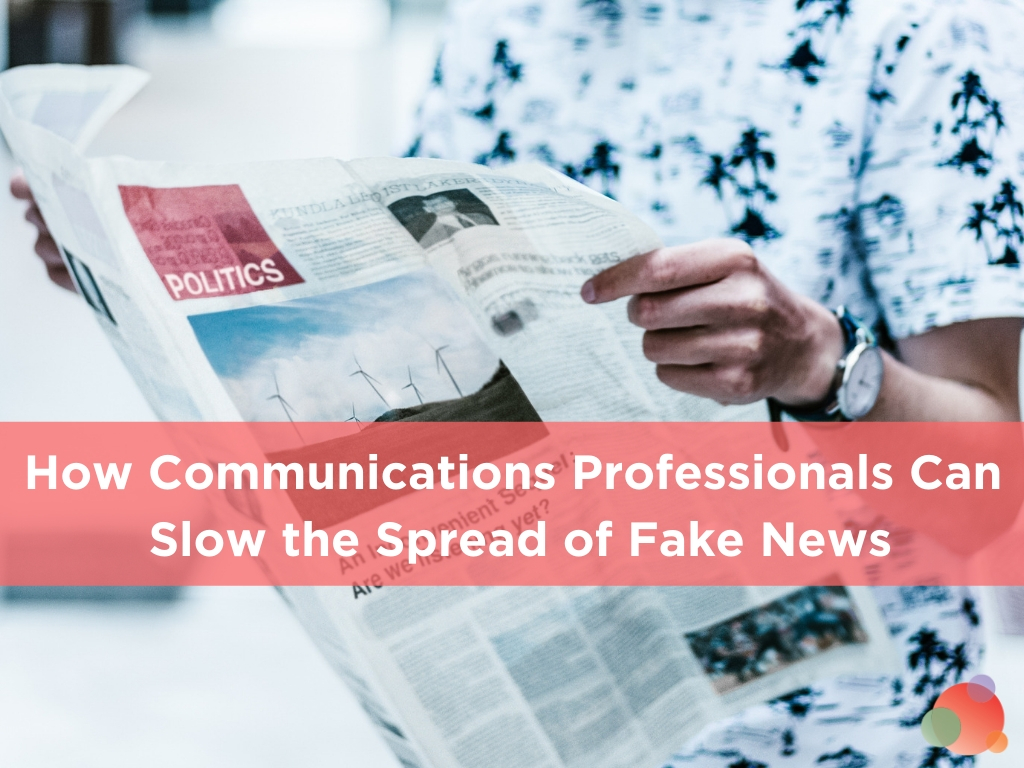 Communications professionals have many roles in an organization.
Communications professionals have many roles in an organization.
And one of our primary responsibilities is being authentic and transparent with audiences by providing accurate and truthful content.
Fake news is everywhere these days, and travels six times faster than real news.
Yet false stories aimed at manipulating public opinion aren’t new.
Of course, they reach people more quickly online.
Social Media and Fake News
With today’s emphasis on social media, fewer people spend the time to check their news sources.
In a Carter-Ruck Report, Dr. Jonathan Eyal, of the Royal United Services Institute, says:
The peculiarity of fake news is not deception and lies as such, but the intentional use of such practices in strategic mass communication campaigns, deploying a dangerous combination of social media, computer software, mathematical algorithms, and sophisticated advertising techniques.
The report also shows that less than half of readers were aware of the information’s original source.
That’s not surprising.
Even information from established media sources can come via news aggregator platforms, such as Facebook or Google.
The Role of Journalists and Communications Professionals
A journalist’s job is to inform the public.
We expect journalists to check the facts and accuracy of a story before they publish it.
In the same light, communications professionals should review data and craft accurate messages whenever we set out to inform the public.
With digital media, anyone can express an opinion and have a voice.
And this makes the work of “traditional gatekeepers” like media even harder.
“Eighty-three percent of the Europeans say fake news is an existential threat to their way of life”, according to Eurobarometer survey, conducted by the European Commission.
Technology and Automation
Because much of our news flow happens online, public misinformation spread quickly via technology and automation.
The 2018 Carter-Ruck Report says:
There are communities of users on social media who both promote and engage with fake news, and it means that there is a fair amount of this stuff flourishing on sites like Facebook and Twitter.
This underscores the need for brands to be credible and authentic.
The Public is Losing Trust
It’s no secret that trust is declining globally.
And it’s hard to build credibility in an age of doubt. And yet, communications professionals still strive to build trust with audiences.
This means brand authenticity should be linked to an organization’s purpose and values, and reinforced through communications.
Brands need to be relevant, and stay true to customers by responding to their needs, especially in an age of noise.
How Does Fake News Affect Your Organization?
Fake news can destroy a company’s reputation, so organizations must be ready and able to respond swiftly.
And communications professionals need to be more adept at measuring results.
In particular, why and how messages are shifting consumer behavior, and changing brand perception and public opinion.
It’s true that people are looking for more meaningful content.
Brands and communication professionals should focus on topics people care about.
Subjects that pique an audience’s curiosity, and make them want to learn more.
Make Authenticity a Priority
Communications professionals talk about emotional storytelling, so brand stories should be both eye-catching and compelling.
Emotional storytelling can help consumers connect with the brand for a long time.
The problem with fake news is that it is just a fabrication of content.
So be authentic, and make authenticity a priority in your communications.
By using original storytelling, you can create long-lasting relationships.
Because people want to learn new things, and explore fresh ideas and opportunities.
Millions of people around the world identify with Oprah and Ellen DeGeneres because they’re true to themselves.
They add warmth and personality to the content they share, and that helps people form an emotional connection.
How Content Marketing Can Help
Recently, I was at a forum where Matt Potter, chief content officer for John Brown Media, was talking about content creation and meaningful stories.
He said today’s market intelligence (i.e., technology) in combination with human intelligence (i.e., knowing people’s needs and interests) makes for good editorial knowledge.
You need to understand the type of content your audience wants to be both entertained and informed.
Encourage them to ask questions, be curious, and learn more about a particular topic.
When checking news sources, people should be able to distinguish a fake from a true story.
Fake news is a trend made possible by the decline in media trust.
The Good News: Fake News Could Fade Away
Why will it fade away? Because people are looking for authenticity.
People are drawn to stories they find interesting.
And in turn, this makes them more knowledgeable about certain topics.
When we read and check information on multiple sources, it becomes harder to be misinformed.
Francis Ingham, director-general of the Public Relations and Communications Association (PRCA), says the future of PR:
…will be automated tracking and monitoring, but our industry is primarily rooted in personal relationships, insight, and creativity. These are the hardest things to mechanize. I can imagine a future in which a robot can write a bad press release. I can’t imagine a robot angling it, making it sing, or selling it in.
By incorporating creativity, authenticity, a human approach, and relationship-building in communications, we’ll collectively help diminish the spread of fake news.
And that’s something we can all look forward to.
Photo by Priscilla Du Preez on Unsplash